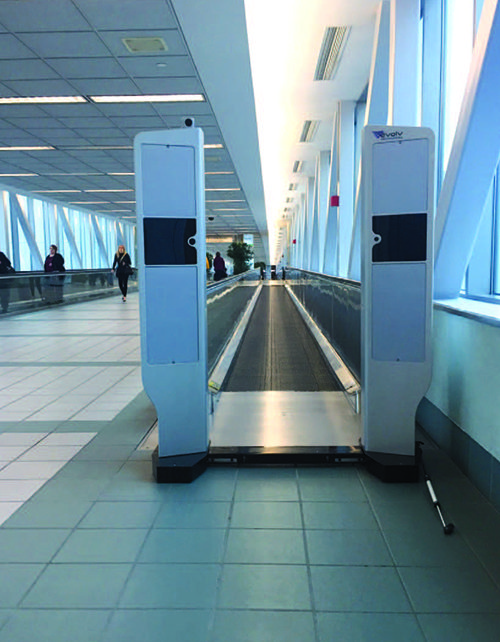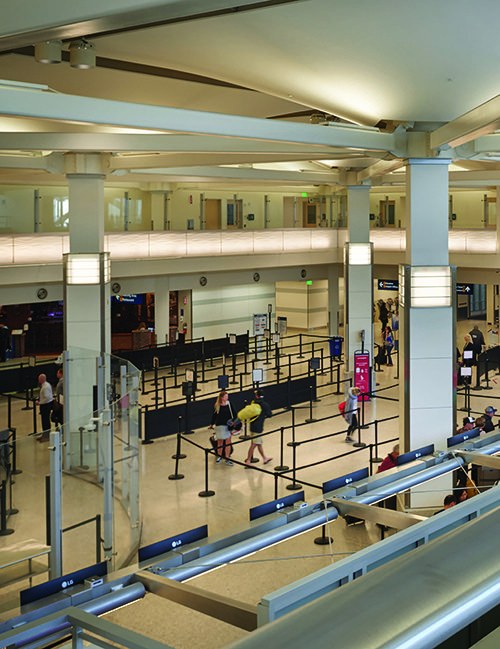Oakland International Airport (OAK) is one of the first U.S. airports to deploy a dual-technology scanner to screen employees working in secure environments. In May 2018, the California airport began using an Edge scanner from Evolv Technology. The equipment combines the screening properties of traditional metal detectors with the nonmetallic screening abilities of millimeter wave equipment, the newest scanners used by TSA at most U.S. airports.
Oakland International Airport (OAK) is one of the first U.S. airports to deploy a dual-technology scanner to screen employees working in secure environments.
In May 2018, the California airport began using an Edge scanner from Evolv Technology. The equipment combines the screening properties of traditional metal detectors with the nonmetallic screening abilities of millimeter wave equipment, the newest scanners used by TSA at most U.S. airports.
The portable scanner is deployed on a random schedule at OAK’s main employee entrance to secure areas, including the airfield. Security personnel wheel the machine in for use, then store it until the next unscheduled use.
|
facts&figures Project: Employee Screening Location: Oakland (CA) Int’l Airport Scanner: The Edge, by Evolv Technology Points of Difference: Walk-through scanner combines metal detection with millimeter wave technology; allows employees to leave cellphones, wallets & keys in their pockets during screening Throughput: 75-100 employees/hr at OAK; equipment capacity is 600-800 people/hr Key Benefit: Maintain security while providing more palatable process for employees compared to physical pat-downs |
The airport originally established an employee screening program in 2015, after a marijuana smuggling ring involving baggage handlers was uncovered at the airport. “We put together a holistic threat mitigation program so it would not happen again,” explains OAK Security Manager Doug Mansel. “One part of that program is employee screening.”
The recent investment in an Edge scanner is the latest evolution in that program. Before OAK added in the new technology, security personnel patted down employees and searched their bags.
“You can imagine that this is not real popular with employees,” Mansel muses.
Welcome Change
With the new scanner, employees simply walk through the device, without having to remove keys, wallets and cellphones from their pockets. Only large bags and purses are still opened. Lunch bags pass right through. “The whole process is much more comfortable for the employees,” relates Mansel. “The employees like it primarily because they don’t have to be patted down.”
The scanner is not necessarily used every day. Instead, it is deployed on an unpredictable rotation, so employees cannot anticipate the day or shift it will be used. When the new machine is not in use, workers are patted down and must divest everything in their pockets.
When the scanner is being used, employees walk between two tall blades/columns at a regular pace. “We scan at the speed of life,” says Bill McAteer, an Evolv account executive. “Just walk through at your normal pace with your hands at your side.”
 The millimeter wave technology scans individuals as they approach the device for nonmetallic threats. It bounces microwaves off the body, looking for dense materials consistent with that of a “suicide vest” between the skin and clothing. The blades on the device are the metal detectors that screen for weapons. As employees walk beyond the blades, more microwaves complete the search.
The millimeter wave technology scans individuals as they approach the device for nonmetallic threats. It bounces microwaves off the body, looking for dense materials consistent with that of a “suicide vest” between the skin and clothing. The blades on the device are the metal detectors that screen for weapons. As employees walk beyond the blades, more microwaves complete the search.
Incorporated smart technology provides security officers with a report on a mobile tablet before each employee leaves the device. If an anomaly is detected, a square will appear on a body image at the location in question, and the officer will pat the individual down or use a hand wand to check for security threats or banned items.
Mansel reports that the scanner has not detected any guns coming into the airport, but it has caught knives. Some were deemed necessary for an employee’s job; the rest were confiscated.
Throughput
In total, OAK has about 6,500 security badge holders. Depending on the day and shift, the airport runs 75 to 100 workers an hour through its employee checkpoint.
“The machine has great throughput, which is one of the reasons we like it so much,” Mansel remarks.
The Edge can screen 600 to 800 people per hour, which meets the peak traffic periods at shift changes and is much more efficient than the throughput capabilities of a metal detector, notes McAteer.

Occasionally, OAK screens employees as they are leaving secured areas. Like the entry checks, these screenings are also performed on a random schedule. “We are not seeing an interest in these [exit] screenings from other airports,” says McAteer.
 Mansel initially learned about the Edge scanner at a conference sponsored by the Airports Council International-North America. Evolv subsequently shipped a unit to OAK for a one-week trial, and airport personnel gave the equipment good reviews.
Mansel initially learned about the Edge scanner at a conference sponsored by the Airports Council International-North America. Evolv subsequently shipped a unit to OAK for a one-week trial, and airport personnel gave the equipment good reviews.
“That was huge to test the device, as it is a big investment,” Mansel remarks. “We put it through the paces, and it worked well.”
While OAK purchased their scanner outright, Evolv no longer sells its machines. Instead, the company issues the equipment under a four-year lease program that includes service, maintenance, upgrades and remedial training.
According to McAteer, a handful of other airports including Dallas Fort Worth International and San Juan Airport in Puerto Rico also have the machines. One U.S. airport that will soon go live with the equipment is considering Evolv’s optional facial recognition technology. Facial scans are performed as employees approach the device, and security officers get the reading and identification confirmation as the rest of the scans are being performed.
Additional Applications
The primary purpose of Evolv scanners is to prevent mass casualty events. The company, formed five years ago, spent several years researching the technology to combat mass casualty threats. The first device was deployed in 2017 at a performing arts center in New York City. “They are used to detect guns and bombs and supplement security in areas where there are large groups of people assisting in making public areas safe,” explains McAteer.

Today, Evolv has about 100 machines deployed in the U.S. The largest users are performing arts centers, large sporting venues, hospitals and corporations. For the most part, they are used in private venues where the public is being screened upon entry for large, crowded events. “We are in a couple of iconic locations,” notes McAteer. “One is in Seattle, where they screen 1 million people a year using two machines.”
According to Evolv, one London airport will soon install a scanner to screen people entering the public areas of the terminal, not just ticketed passengers and/or employees. McAteer does not foresee U.S. airports following suit anytime soon absent a major threat.



